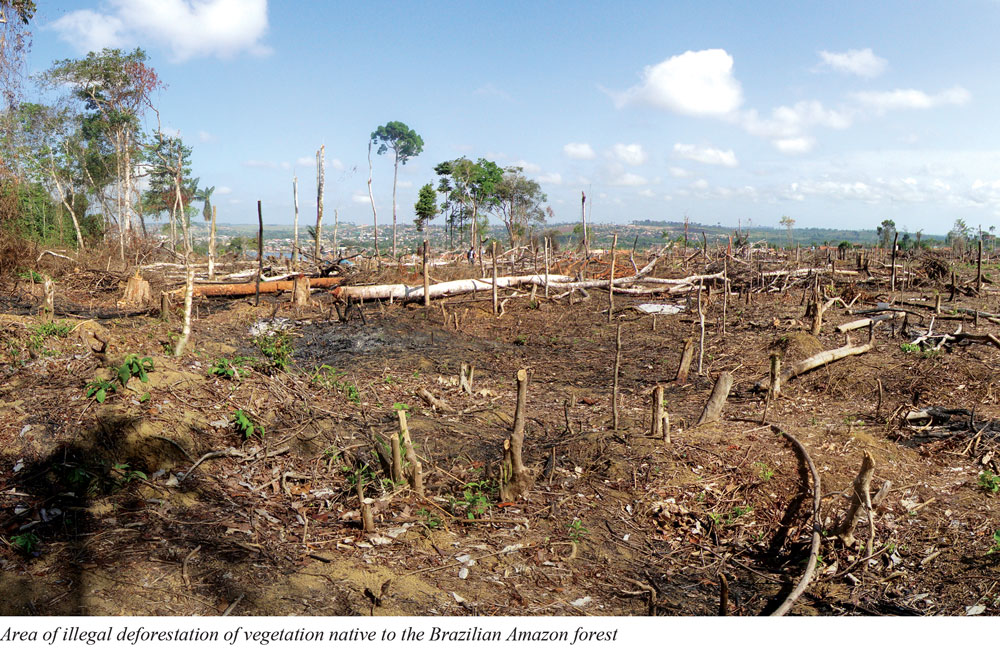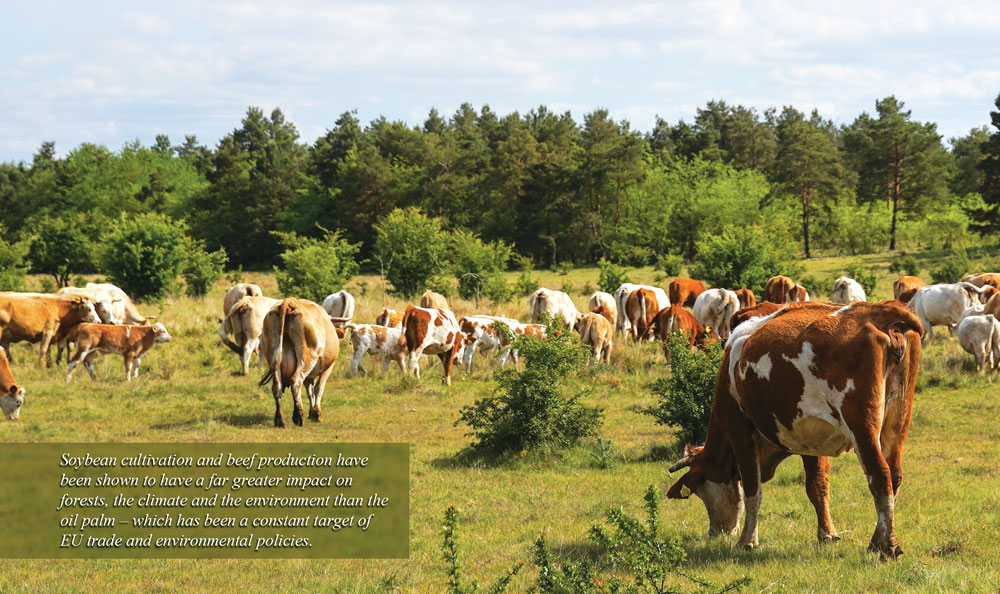



It must share the blame
October, 2020 in Issue 3 - 2020, Environment
The European Union (EU) has unilaterally stepped up action to ‘protect’ forests worldwide, without first sufficiently addressing deforestation in its own backyard. This is despite the fact that its forests account for just 38% of the total land area today.
The global forest area declined from 31.8% in 1990 to 30.8% in 2016. In contrast, Malaysia’s forests still cover about 55% of the land area. Following a decline of its forest area between 1990 and 2005, there was a laudable recovery by 2016 to the 1990 level due to action spearheaded by the government.
In July 2019, the European Commission (EC) adopted a ‘Communication on Stepping up EU Action to Protect and Restore the World’s Forests’. This targets protecting and improving the health of forests, especially primeval forests, and significantly increasing sustainable, biodiverse forest cover worldwide. General priorities include:
Through its Communication, the EU has signalled its plan to ‘work in partnership’ with commodity producers in third countries to rein in deforestation and forest degradation. But does it have any intention to strive for true partnerships?
An earlier draft of the Communication had suggested the title ‘Cooperation and coordination with third countries’, adding that ‘building effective partnerships with producer countries in the tropical domain to support the uptake of sustainable agricultural and forestry practices’ should be a possible form of action.
However, the final text reads that ‘in line with EU development-cooperation principles, the EC will work in partnership with producing countries to fight deforestation and forest degradation’. The watered-down wording is indicative of a one-way approach in the plan of action.
Deforestation is a global issue that requires cooperation and multilateral solutions. Much more can be achieved through bilateral, plurilateral and/or multilateral cooperation than by unilateral action, even when masked as ‘working in partnership’.

Forest degradation in the EU
Recent examples show that the EU itself is not free of issues of deforestation and forest degradation. In 2016, the Polish government stepped up logging in the Białowieża Forest, one of Europe’s last primeval stands of woods. According to official information, 150,000 trees were felled in 2017 alone.
Operations were only halted when the European Court of Justice intervened in April 2018 because the forest is a UNESCO world heritage site. The Court found that the government had failed to fulfil its obligations to protect the forest, and ordered the immediate revocation of logging permits.
Another example is the primeval Hambach Forest in Germany, which is rich in biodiversity and home to species regarded as important for conservation purposes. Although the plan to cut down large parts of the remaining 10% of the forest for brown coal mining was suspended in 2018, the forest remains severely threatened by the expansion of the local brown coal mine.
In addition, data published in the journal Nature Research suggests that Europe has lost an immense area of forest to harvesting of timber. This significantly reduces the region’s carbon absorption capacity.
Many of the EU’s forests are managed for timber production, and thus harvested regularly. But according to satellite data, the loss of biomass (i.e. the total quantity or weight of organisms in a given area) increased by 69% from 2016-18, compared to 2011-15. Over the same period, the area of forest harvested increased by 49%.
This indicates that much more harvesting has occurred in a short period, even accounting for natural cycles and the impact of forest fires and heavy snowfall. The harvested area can normally be expected to vary by less than about 10% owing to cycles of planting and growing, and similar effects, according to the lead author of the study from the EU Joint Research Centre.
Other factors have contributed to the increase in harvesting, including higher demand for wood as a fuel and expansion of markets for timber and other wood products. The satellite data could be an early indicator of unsustainable demands on the EU’s forests. The loss of forest biomass from 2016-18 was most pronounced in Sweden, which accounted for 29% of the rise in harvesting, and Finland (22%).
There are other threats to the EU’s forests. In May this year, dramatic developments of forest damage and the threat of a ‘Forest Extinction 2.0’ were reported in Germany. This refers to a forest crisis in the 1980s, due to acid rain caused by air pollution. Notably the result of acid-forming exhaust gases, it was one of several factors behind a destructive effect on forests. The situation had prompted intense public debate – termed ‘Forest Extinction’ – across Europe.
Climate change has had a drastic impact on forests in different parts of Germany. In particular, conifer species like pine and spruce suffer because of extreme conditions such as heat, drought and storms. In Bavaria and other Federal States, more and more pine trees are dying in the deeper and warmer locations. The black pine species which, until now, had been considered heat resistant, has also been affected. About 80% of the largest black pine stand in Würzburg district has been damaged.

Where the fault lies
The Communication cites a 2016 report by the UN Food and Agriculture Organisation that ‘agricultural expansion for the production of commodities (e.g. soybean, beef, palm oil, coffee, cocoa) drives about 80% of all deforestation specifically in tropical countries, while mining, urbanisation and infrastructure are responsible for less than 10% each’.
Soybean cultivation and beef production have been shown to have a far greater impact on forests, the climate and the environment than the oil palm – which has been a constant target of EU trade and environmental policies. Soybean currently covers an area that is six times larger than that under oil palm. The expansion of livestock production for beef is also a key cause of deforestation.
In Latin America, 70% of the forested land in the Amazon region has been converted to pasture. Recent reports note that up to 80% of deforestation in the Amazon can be attributed to the cattle ranching sector. In 2017, the estimated remaining forest cover in the Brazilian Amazon region was 3,316,172 sq km, or only 80.9% of the forest cover recorded in 1970. At the current rate of deforestation, by 2030, the Amazon rainforest will be reduced by as much as 40%.
Cultivation of feed crops, such as soybean, cover a large part of the remaining 30% of once-forested land in the Amazon. Brazil, the world’s largest producer of soybean, has quadrupled production over the last two decades and is expected to add to this over the next 10 years. Notably, pig farmers in the EU, the world’s largest exporter of pork, depend on Brazilian soybean for feed.
Beef production is considered the biggest driver of tropical deforestation worldwide – being responsible for more than twice that caused by the production of soybean, palm oil and wood products combined. It is estimated that the deforestation for cattle ranching alone releases 340 million tonnes of carbon to the atmosphere annually, equivalent to 3.4% of current global emissions.
The EU is, in part, responsible for the deforestation in Brazil – 20% of Brazil’s beef and soybean exports to the EU is produced on land that was illegally deforested, according to a report published in Science magazine on July 16, 2020.
The study – led by authors from Brazil, Germany and the US – used a special software to analyse 815,000 rural properties and identify areas where illegal deforestation associated with soybean and beef production is taking place in the Amazon and Cerrado – the vast tropical savanna in the centre of Brazil – and how much of these products is for the EU.
The authors also made an estimate of greenhouse gas emissions from deforestation that is linked to soybean and beef exports. They further pointed out the shared culpability of international buyers: “Between 18% and 22% – possibly more – of annual exports from Brazil to the EU are the fruit of illegal deforestation,” said lead author Raoni Rajão, a professor at Brazil’s University of Minas Gerais in Belo Horizonte.
According to official data, a record 3,700 sq km of the Amazon were deforested in the first half of this year, up 25% from the same period in 2019. The report noted ‘the responsibility of all foreign markets in this process’.
Deforestation by the Brazilian agriculture industry ‘destroys the forest to gratify the European appetite’, said the authors, adding that ‘two million [tonnes] of soy[bean] grown on illegally deforested land reaches the EU each year’.
No rhetoric – clearly, the facts speak for themselves.
Uthaya Kumar
Regional Director
MPOC Brussels
